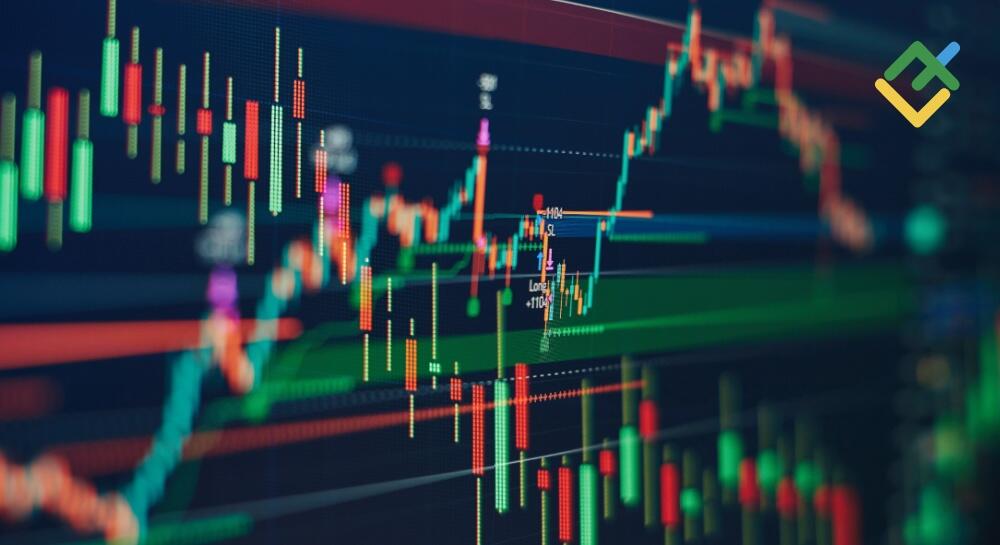The Schaff Trend Cycle STC indicator is a technical analysis tool that combines the advantages of MACD and stochastic oscillators. Its primary features include the implementation of smoothed moving averages and the analysis of cyclical patterns, which help to filter false signals.
The STC indicator is particularly advantageous for short- and medium-term trading due to its high accuracy and rapid responsiveness to market fluctuations. This technical indicator is essential for identifying price trends and predicting market phases, making it a staple tool in volatile market conditions.
This article provides a comprehensive overview of the STC indicator, including its calculation formula and its advantages over other technical analysis indicators. In addition, it examines effective trading strategies in various market conditions.
The article covers the following subjects:
Major Takeaways
- The Schaff Trend Cycle (STC) indicator is an oscillating indicator based on moving averages and cycle analysis.
- The STC indicator reacts faster to market changes than the MACD indicator.
- The Schaff Trend Cycle indicator helps identify trends and find reversals, generating fewer false signals.
- The tool is used in trading strategies to find optimal entry and exit points for opening trades.
- The STC performs in all market conditions but is most effective in trending markets.
What is the Schaff Trend Cycle Indicator?
The Shaff STC trend cycle indicator was developed in the 1990s by trader and programmer Doug Shaff, who owns FX-Strategy, a company specializing in the development of software solutions for chart analysis. Schaff observed that currency pairs on Forex follow cyclical patterns — periods of acceleration alternate with periods of deceleration — and set out to improve the accuracy and speed of market trend identification.
The STC technical indicator is an advanced market analysis tool that combines the features of the MACD and stochastic oscillator. Its primary objective is to identify market trends, determine optimal entry and exit points, and forecast potential trend reversals. The STC is based on the analysis of price fluctuations and smoothed moving averages, which helps to reduce the number of false signals generated by the indicator.
Initially, the indicator was used exclusively in the Forex market. However, due to its versatility, it gained popularity among traders engaged in stock, commodities, and cryptocurrency markets. STC’s primary advantage over standard oscillators lies in its rapid response to changing market conditions, enabling traders to make more precise assessments of market trend phases. The tool’s straightforward default settings and high efficiency make it a valuable indicator for traders with varying levels of experience.
Fig. 1: The Schaff Trend Cycle indicator plotted on a price chart.
Technical Mechanism of STC
The Schaff trend cycle is based on a combination of exponential moving averages (EMAs) and a stochastic oscillator, which helps determine trend cycles more precisely. Its main principle is to measure the strength of the trend and the speed of price changes. STC values range from 0 to 100, with STC values above 75 indicating that an asset is overbought and below 25 indicating that it is oversold.
Unlike the classic MACD line, which uses the difference between two EMAs, the STC adds cycle filtering, making it more effective for identifying trends.
The STC calculation mechanism includes the following three main stages:
-
Calculating MACD based on two EMAs.
-
Applying a stochastic oscillator to MACD values to identify market cycles.
-
Additional smoothing of the resulting value to eliminate price noise.
This mechanism enables the Shaff indicator to respond to changes in the financial market more quickly than the classic MACD, reducing the likelihood of false signals. Thanks to its high sensitivity, the indicator is particularly useful in rapidly evolving market conditions, making it an indispensable tool for short-term trading or scalping.
To increase the accuracy of STC signals, the indicator should be combined with other technical analysis tools such as the RSI or support and resistance levels.
STC Calculation Method
Since the STC indicator employs moving averages and a stochastic oscillator to determine market cycles, its calculation involves several key steps:
-
Calculation of the MACD based on the difference between two exponential moving averages (EMA) w23 and 50 periods, which are the default values for the Forex market.
-
Applying the stochastic oscillator to the MACD values allows you to identify cyclical fluctuations.
-
Filtering by smoothing the resulting value using an additional EMA, which reduces the influence of market noise. This parameter is usually set to 10.
Formulas for calculating STC:
- MACD = EMA (fast) – EMA (slow)
- Stochastic MACD value = ((MACD – MinMACD) / (MaxMACD – MinMACD)) × 100
- STC = EMA (stochastic MACD)
This method enables the STC to respond more swiftly to trend fluctuations compared to the traditional MACD, allowing traders to accurately pinpoint entry and exit points in the market.
Comparison STC with MACD
The Schaff STC trend cycle indicator and the MACD (Moving Average Convergence/Divergence) indicator are popular technical analysis tools, but they have different operating principles and varying effectiveness in different market conditions. The primary advantage of the Shaff STC trend cycle strategy is its ability to identify trend reversals more quickly, thanks to the use of a stochastic oscillator. The MACD indicator, on the other hand, tends to lag behind, but can be useful for identifying long-term trends.
The key differences between these indicators are presented in the table below:
|
Characteristics |
Schaff Trend Cycle, STC |
MACD |
|
Indicator type |
Oscillator |
Trend |
|
Calculation |
Difference between EMAs + stochastic |
Difference between EMAs |
|
Sensitivity |
High |
Low |
|
False signals |
Less frequent |
More frequent |
|
Strategy |
Short-term trading |
Medium-term trading |
The Schaff Trend Cycle strategy is better suited for active traders who focus on rapid price movements and want to minimize false signals. Thanks to its sensitivity to market changes, the STC indicator allows you to identify price changes and potential trend reversals more quickly. The MACD indicator is more useful for long-term investors seeking confirmed trends and those who prefer stable trading signals.
Another advantage of the STC is its versatility. The indicator can be used for both short-term and medium-term trading. Thanks to its reliability and flexibility, the tool is becoming increasingly popular among traders having varying levels of experience, helping them interpret market conditions to maximize profits.
Key Characteristics of STC
The STC indicator is a powerful technical analysis tool that combines the properties of trend and stochastic indicators. It helps traders to identify market trends, find entry and exit points, and minimize false signals. It is based on the MACD indicator and the stochastic oscillator, which makes it more prompt and accurate compared to indicators that use only one calculation method.
Key features of STC:
- Quick response to market changes. The indicator utilizes smoothed moving averages, enabling you to quickly identify trend reversals.
- Cyclical analysis. The STC takes market cycles into account, making it useful in rapidly changing market conditions.
- Fewer false signals. The tool generates false signals less frequently compared to the MACD indicator, thanks to additional filtering using stochastics.
- Flexibility. Moving average and signal filtering parameters can be adapted to different trading styles and markets.
- Optimal for short-term trading. It is particularly effective in scalping and intraday trading.
- Applicable to all market conditions. The indicator is suitable for both trending and flat markets.
The STC has become a popular choice among traders seeking to enhance the accuracy of trading signals and optimize the effectiveness of their strategies in the rapidly evolving realm of financial markets.
Schaff Trend Cycle and Interpretation of Trading Signals
The Schaff Trend Cycle indicator generates trading signals based on the analysis of cyclical patterns and the fluctuations of moving averages. The STC line fluctuates within the range of 0 to 100, with 25 and 75 considered key levels. When the indicator line crosses the 25 and 75 values, overbought and oversold conditions occur in the market.
Key STC trading signals:
1. Buy signal:
-
The STC crosses the 25 level from below.
-
A rising STC line indicates the end of a downtrend and the beginning of an upward price movement.
-
Additional confirmation may come from an increase in trading volume, a breakout of resistance levels, or the emergence of trading patterns.
2. Sell signal:
-
The STC crosses the 75 level from above.
-
The falling STC line indicates an overbought condition and a possible start of a downtrend.
-
Changes in trading volume, breakouts of key support levels, and the development of trading patterns can confirm the signal.
3. Filtering false signals:
-
In range bound markets, the STC may generate false signals.
-
For filtering, it is recommended to use additional technical indicators, such as the RSI, support and resistance levels, and trading volumes, to confirm the signal.
Fig.2: Opening long positions after receiving buy signals.
The STC’s high sensitivity facilitates timely decision-making, enabling traders to open positions with better precision relying on overbought and oversold levels. This versatility positions the STC as a standalone tool, offering unparalleled efficiency in the financial market. However, as with any technical analysis tool, the Schaff Trend Cycle indicator provides the most effective buy and sell signals in clear uptrends or downtrends after a correction has ended in the direction of the primary trend.
Fig.2a: Opening a short position after receiving a sell signal.
Let’s consider a scenario where the Schaff Trend Cycle indicator is used in conjunction with support levels in the currency market. In October 2024, the indicator line crossed the 75 level from above, signaling an imminent trend reversal. However, in contrast to the previous signal received in August, the price continued to decline and crossed the base level of the Double Top pattern at 1.1000 a few days later. This combination of factors generated sell signals and indicated a bearish trend, within which the price reached 1.0760 in November 2024.
At the end of October, the Schaff indicator line formed a bullish crossover and rose above the 25 level, signaling a corrective move in the opposite direction to the downtrend. In November, the STC line crossed the 75 level from top to bottom once again, and the EURUSD pair fell below the support level at 1.0760, thereby confirming the end of the correction and the resumption of the bearish trend.
As a result, a thorough examination of Schaff Trend Cycle signals in conjunction with support levels enabled us to promptly identify the trend reversal and filter out false signals that emerged during a new market phase.
When looking for buy signals, swing traders can use resistance levels in conjunction with the indicator’s signal line readings. Notably, optimal trading results require following the primary trend and identifying potential trend reversals.
Practical Applications of Schaff Trend Cycle in Trading
The Schaff Trend Cycle is widely used in various financial markets, including Forex, the stock market, and the cryptocurrency market. The indicator’s signal line is designed to respond promptly to trend changes, making it highly effective in scalping, intraday, and medium-term trading strategies. The STC has proven to be a reliable tool for identifying market reversal points, a feature that sets it apart from traditional oscillating indicators. Its precision in detecting these critical junctures has been a significant advantage, leading to a notable reduction in the number of false signals.
In the Forex market, the indicator facilitates the analysis of currency pairs, such as the EURUSD and GBPUSD pairs. When the STC exits the oversold zone, traders can consider this a buy signal, especially if the price has crossed the resistance level, offering an additional confirmation. In medium-term strategies, the STC can determine corrective price movements and find favorable entry points in the direction of the main trend.
Fig.3: The STC indicator signaled that the Tesla market was overheated in December 2024.
In the stock market, the STC indicator helps detect trend changes before the publication of company financial reports or macroeconomic data. For example, when analyzing stocks, traders use the STC indicator to pinpoint moments of market overheating and lock in profits in a timely manner.
In the cryptocurrency market, the STC has become the top choice among active crypto traders speculating on Bitcoin, Ethereum, and other altcoins. The high volatility of the cryptocurrency market makes the STC particularly effective for filtering out false signals. When trading ETHUSDT, the STC indicator can be plotted on lower time frames to identify minor corrections or trend reversal points.
Fig.4: In November 2024, the STC signaled growth when the price crossed the resistance level of 2,810. In December, the indicator signaled a decline in ETHUSDT quotes when the price crossed the 3,515 resistance level.
The Schaff Trend Cycle indicator is a highly adaptable tool that can be applied to various asset classes and trading strategies. It assists traders by enabling them to respond to market changes in a timely manner and make more informed trading decisions.
Optimal Settings and Configuration of STC
The Schaff Trend Cycle settings should be adjusted according to the market in which it is used and the trading strategy employed. The correct selection of parameters is essential for traders to minimize false signals and enhance the accuracy of entry points.
In the context of Forex trading, the most commonly utilized settings include a fast exponential moving average (EMA) with a period of 23, a slow exponential moving average (EMA) with a period of 50, and a stochastic oscillator with a period of 10. These parameters are designed to facilitate the effective tracking of short-term and medium-term trends, thereby enabling the timely entry and exit from the market.
In the stock market, where trends evolve more gradually, it is generally advisable to employ EMAs with periods of 50 and 100, along with a stochastic period of 15. This setup reduces the indicator’s sensitivity, thereby minimizing the likelihood of false signals.
In the realm of cryptocurrency trading, high market volatility often requires “faster” settings, such as EMA periods of 10 and 21 and a stochastic period of 5. These parameters enable traders to respond quickly to changes in the market trend. However, the indicator will generate more false signals.
The settings for the STC indicator can be adjusted based on the time frame and trading style. Lower periods will be suitable for scalping, while for medium-term trading, it is recommended to increase the smoothing parameters.
Common Trading Strategies
The Schaff Trend Cycle Indicator is a powerful tool for identifying market trends and potential reversal points. Due to its versatility, this tool can seamlessly integrate into various trading strategies, providing traders with reliable signals for entering and exiting the market. Let’s examine the most common trading strategies involving the STC.
1. Trend following strategy.
As part of this strategy, the STC helps determine the current market direction. When the indicator line moves steadily upward and crosses the key level of 50, this indicates the development of an uptrend and gives a buy signal. If the STC curve declines and crosses the 50 level from above, this indicates a bearish trend and generates a sell signal.
2. Trend reversal strategy.
The STC is a valuable tool that enables users to identify price extremes. If the indicator rises above 75, it may signal that the asset is overbought, which often precedes a downward reversal. A value below 25 points to oversold conditions and the likely start of an upward correction. Despite their high accuracy, reversal signals require additional confirmation, as corrective movements are often short-lived.
3. Combining STC with other technical indicators.
Since the STC is not immune to false signals, it is often used in conjunction with the RSI, MACD, or moving averages. If STC and RSI are simultaneously moving in the same direction, for example, both move away from the oversold level, the probability of a successful trade increases. Moving averages can provide further confirmation of the trend direction and help filter out weak and unreliable signals.
4. Using STC on different time frames.
STC is a versatile tool that can be used in both short-term trading and long-term strategies. Day traders utilize it on lower time frames to facilitate rapid entry and exit from the market. Investors apply the indicator to higher time frames to determine the overall market direction.
When used with effective risk management, the Schaff Trend Cycle indicator enables traders to discern market signals with greater precision, thereby enhancing their trading performance.
Fig.5: The combination of STC and RSI indicators revealed a trend reversal.
STC Performance in Different Market Conditions
The STC indicator performs most effectively in trending markets, where the price moves within a clear trend. The indicator’s swift response to price changes enables traders to quickly find entry and exit points. The indicator is particularly useful at the beginning and end of a trend, as it helps minimize lag, making it a valuable tool for traders seeking to capitalize on short-term and medium-term market movements.
In flat markets, the STC can generate false signals because these markets do not exhibit clear trends. In such situations, it is recommended to combine it with other indicators, such as moving averages or support and resistance levels, to filter out unreliable signals.
The STC is a powerful, standalone technical analysis tool for trading when the asset’s price is moving according to a prevailing trend. However, it requires additional signal filtering when the price is moving sideways. It is essential to discern trending markets and select financial instruments that exhibit a clear directional movement.
Limitations and Potential Drawbacks
Despite its effectiveness, the STC indicator has several limitations that are important to consider when using it. The primary drawbacks are related to its sensitivity to market noise and dependence on market conditions.
Main limitations of the STC:
- False signals in a sideways market. During periods of flat trading, the STC may generate false signals, creating pitfalls for traders.
- Dependence on settings. Incorrect selection of EMA and stochastic periods may reduce signal accuracy.
- Lack of efficiency without confirming indicators. To improve accuracy, it is recommended to use the STC together with support and resistance levels, moving averages, or volume indicators.
- Delay on higher time frames. When analyzing long-term trends, the indicator may lag behind the price movements, which reduces its effectiveness in position trading.
To mitigate these limitations, the STC should be combined with other technical analysis tools and fine-tuned to align with specific market conditions.
Best Practices and Risk Management
To use the Schaff Trend Cycle indicator effectively, it is important to consider market conditions, combine it with other indicators, and apply risk management strategies. The STC is particularly useful in trending markets but requires additional filters to perform effectively in sideways markets.
One of the most effective strategies is to combine the STC indicator with support and resistance levels, which serves to eliminate false signals. In addition, it is highly recommended to employ moving averages, MACD, or the RSI to validate the trend direction.
In order to minimize potential risks, it is essential to set stop-loss orders beyond key levels and allocate a maximum of 1-2% of your total deposit per trade. In volatile markets, traders employ shorter STC settings to facilitate a more rapid response to price fluctuations.
Before implementing the strategy on a live trading account, it is essential to conduct a thorough backtest of your strategy using historical data. During this phase, it is crucial to adjust your strategy so that it aligns with the prevailing market conditions.
Fig. 6: A long trade was opened in the BTC market on the correction, according to the STC and RSI indicators, with a minimal risk of 1-2%.
Conclusion
The Schaff Trend Cycle (STC) indicator is a sophisticated technical analysis tool that seamlessly integrates the functionality of the MACD indicator and the stochastic oscillator. Its primary benefit lies in its rapid responsiveness to changing market conditions, making it highly effective for short-term and medium-term trading strategies.
The STC is an effective tool in trending markets, especially when combined with support and resistance levels, moving averages, and oscillators. However, the tool can generate false signals in sideways markets. Therefore, it is essential to conduct a comprehensive analysis employing other technical indicators.
Employing optimal settings, testing strategies, and risk management is crucial in enhancing the precision of market entry and exit, as well as reducing potential losses.
Schaff Trend Cycle Indicator FAQs
The content of this article reflects the author’s opinion and does not necessarily reflect the official position of LiteFinance broker. The material published on this page is provided for informational purposes only and should not be considered as the provision of investment advice for the purposes of Directive 2014/65/EU.
According to copyright law, this article is considered intellectual property, which includes a prohibition on copying and distributing it without consent.








